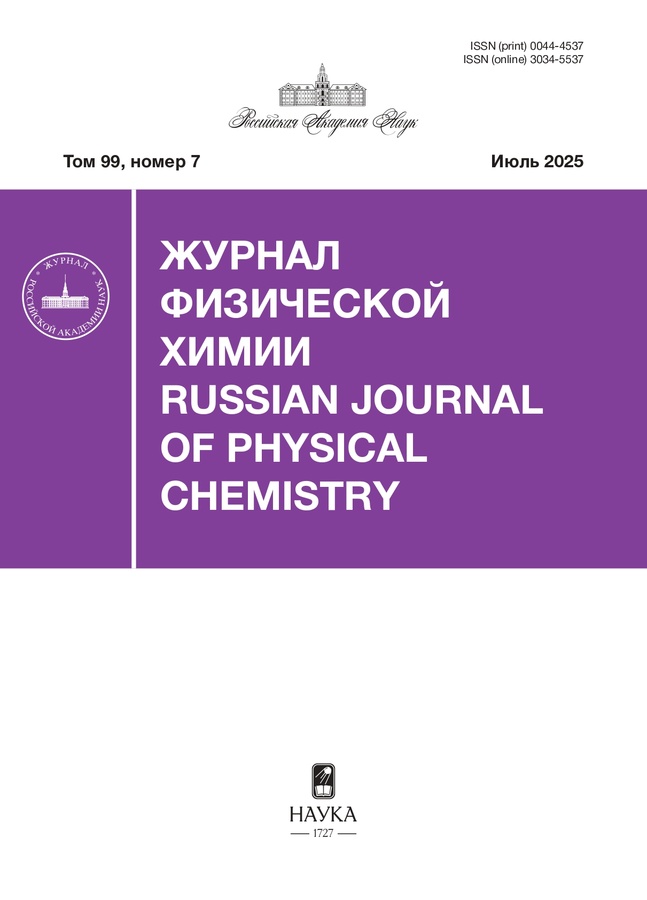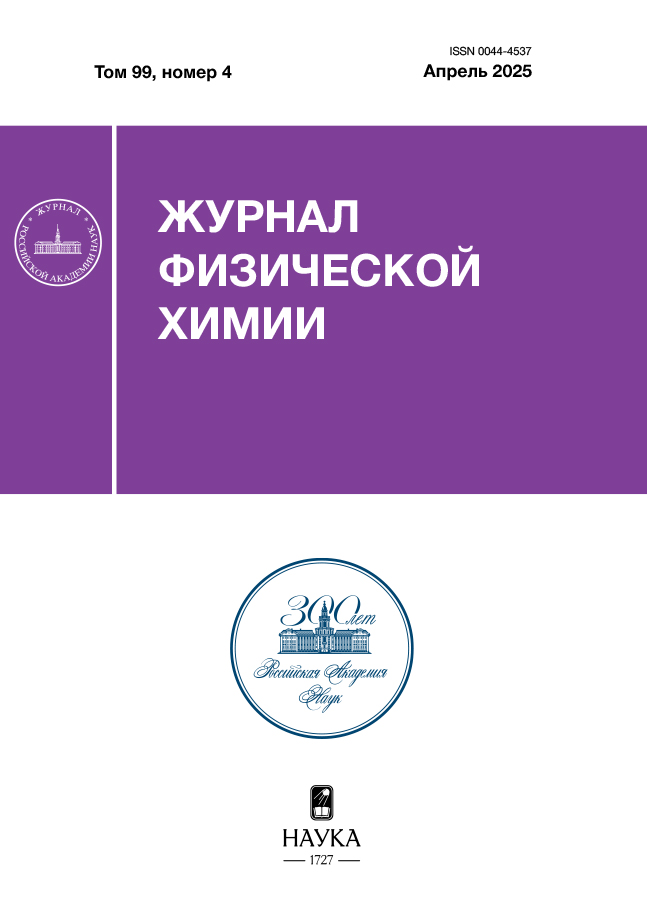Адсорбция и закономерности удерживания галогенадамантанов на графитоподобном адсорбенте Hypercarb в условиях ВЭЖХ
- Авторы: Яшкин С.Н.1,2, Рыжихина Э.В.1, Яшкина Е.А.2, Светлов Д.А.3
-
Учреждения:
- Самарский государственный технический университет
- Самарский региональный центр для одаренных детей
- Испытательная лаборатория по Самарской области ФГБУ “ЦЛАТИ по ПФО”
- Выпуск: Том 99, № 4 (2025)
- Страницы: 654-664
- Раздел: ФИЗИЧЕСКАЯ ХИМИЯ ПРОЦЕССОВ РАЗДЕЛЕНИЯ. ХРОМАТОГРАФИЯ
- Статья получена: 14.06.2025
- Статья одобрена: 14.06.2025
- Статья опубликована: 15.06.2025
- URL: https://ter-arkhiv.ru/0044-4537/article/view/684410
- DOI: https://doi.org/10.31857/S0044453725040142
- EDN: https://elibrary.ru/FPNIQZ
- ID: 684410
Цитировать
Полный текст
Аннотация
Экспериментально в условиях ВЭЖХ определены термодинамические характеристики сорбции (факторы удерживания, теплоты и энтропийные факторы сорбции) различных хлор-, бром- и иодадамантанов из водно-метанольного элюента на графитоподобном материале Hypercarb и октилсиликагеле (SiO2–C8). Показано, что Hypercarb характеризуется самыми высокими показателями структурной селективности в ВЭЖХ в отношении стереоизомеров галогенадамантанов. Установлено, что порядок элюирования изомерных хлор-, бром- и иодадамантанов из среды полярного элюента на Hypercarb в ВЭЖХ полностью совпадает с закономерностями удерживания этих соединений на колонках с графитированной термической сажей в газовой хроматографии. Удерживание рассмотренных галогенадамантанов и галогенаренов на Hypercarb описывается адсорбционным механизмом сорбции, при этом основной вклад в удерживание вносят дисперсионные взаимодействия молекул сорбатов с поверхностью адсорбента. Отмечено, что зависимость значений теплот и энтропийных факторов сорбции от состава и строения галогенадамантанов на Hypercarb описывается молекулярной поляризуемостью и величинами молекулярной площадки сорбатов, а в случае сорбции на SiO2–C8 – липофильностью соединений. Сделан вывод, что найденные закономерности сорбции галогенадамантанов в условиях ВЭЖХ позволяют отнести Hypercarb и SiO2-C8 к сорбентам с 2D- и 3D-типами структурной селективности, соответственно.
Полный текст
Об авторах
С. Н. Яшкин
Самарский государственный технический университет; Самарский региональный центр для одаренных детей
Автор, ответственный за переписку.
Email: snyashkin@mail.ru
Россия, 443100, Самара; 443016, Самара
Э. В. Рыжихина
Самарский государственный технический университет
Email: snyashkin@mail.ru
Россия, 443100, Самара
Е. А. Яшкина
Самарский региональный центр для одаренных детей
Email: snyashkin@mail.ru
Россия, 443016, Самара
Д. А. Светлов
Испытательная лаборатория по Самарской области ФГБУ “ЦЛАТИ по ПФО”
Email: snyashkin@mail.ru
Россия, 443093, Самара
Список литературы
- Щербакова К.Д., Яшин Я.И. //100 лет хроматографии / Под. ред. Б.А. Руденко. М.: Наука, 2003. 670 с.
- Гончарова Е.Н., Статкус М.А., Цизин Г.И., Золотов Ю.А. // Журн. аналит. химии. 2020. Т. 75. № 4. С. 291. https://doi.org/10.1134/S1061934820040036
- Engewald W., Pörschmann J., Welsch T. // Chromatographia. 1990. V.30. № 9/10. P. 537. https://doi.org/10.1007/BF02269801
- Feltl L., Smolková E., Skurovcová M. // Coll. Czechoslov. Chem. Commun. 1979. V. 44. № 4. P. 1116. https://doi.org/10.1135/cccc19791116
- Яшкин С.Н., Новоселова О.В., Светлов Д.А. // Журн. физ. химии. 2008. Т. 82. № 5. С. 968. https://doi.org/10.1134/S0036024408050270
- Kiselev A.V., Nazarova V.I., Shcherbakova K.D. // Chromatographia. 1984. V. 18. № 4. P. 183. https://doi.org/10.1007/BF02276730
- Буряк А.К. // Успехи химии. 2002. Т. 71. № 8. С. 788. https://doi.org/10.1070/RC2002v071n08ABEH000711
- Son J.H., Rybolt T.R. // Graphene. 2013. V. 2. № 1. P. 18. http://dx.doi.org/10.4236/graphene.2013.21004
- Киселев А.В. Межмолекулярные взаимодействия в адсорбции и хроматографии. М.: Высшая школа, 1986. 360 с.
- Кудряшов С.Ю. // Журн. физ. химии. 2024. Т. 98. № 8. С. https://doi.org/10.1134/S0036024424700705
- Dolgonosov A.M. // J. Phys. Chem. B. 1998. V. 102. № 24. P. 4715. https://doi.org/10.1021/jp973218p
- Scott A.M., Gorb L., Burns E. et al. // J. Phys. Chem. C. 2014. V. 118. № 9. P. 4774. https://doi.org/10.1021/jp4121832
- Сережкин В.Н., Прокаева М.А., Пушкин Д.В. и др. // Журн. физ. химии. 2008. Т. 82. № 8. С. 1511. https://doi.org/10.1134/S0036024408080177)
- West C., Elfakir C., Lafosse M. // J. Chromatogr. A. 2010. V. 1217. № 19. P. 3201. https://doi.org/10.1016/j.chroma.2009.09.052
- Яшин Я.И., Яшин А.Я. // Рос. хим. журн. (Ж. Рос. хим. об-ва им. Д.И. Менделеева). 2003. Т. XLVII. № 1.
- Pereira L. // J. of Liquid Chromatography & Related Technologies. 2008. V. 31. № 11. P. 1687. https://doi.org/10.1080/10826070802126429
- Яшкин С.Н., Курбатова С.В., Буряк А.К. // Изв. РАН. Сер. хим. 2001. Т. 50. № 5. С. 792. https://doi.org/10.1023/A:1011350908009
- Яшкин С.Н., Мурашов Б.А., Климочкин Ю.Н. // Журн. физ. химии. 2011. Т. 85. № 4. С. 758. https://doi.org/10.1134/S0036024411040315
- Яшкин С.Н., Светлов Д.А., Мурашов Б.А. // Журн. прикл. химии. 2013. Т. 86. № 3. С. 463. https://doi.org/10.1134/S1070427213030245
- Яшкин С.Н., Дмитриев Д.Н., Яшкина Е.А. и др. // Изв. РАН. Сер. хим. 2022. Т. 71. № 9. С. 1878. https://doi.org/10.1007/s11172-022-3605-0
- Prŭšová D., Colin H., Guiochon G. // J. Chromatogr. A. 1982. V. 234. № 1. P. 1. https://doi.org/10.1016/S0021-9673(00)81776-8
- Яшкин С.Н., Соловова Н.В. // Журн. физ. химии. 2004. Т. 78. № 2. С. 344.
- Экспериментальные методы в адсорбции и молекулярной хроматографии / Под ред. Ю.С. Никитина и Р.С. Петровой. М.: Изд-во МГУ, 1990. 318 с.
- Шатц В.Д., Сахартова О.В. Высокоэффективная жидкостная хроматография: основы теории, методология, применение в лекарственной химии. Рига: Зинатне, 1988. 390 с.
- Калашникова Е.В., Лопаткин А.А. // Изв. РАН. Сер. хим. 1997. Т. 46. № 12. С. 2173. https://doi.org/10.1007/BF02495252
- Kalashnikova E.V., Kiselev A.V., Petrova R.S. et al. // Chromatographia. 1979. V. 12. № 12. P. 799. https://doi.org/10.1007/BF02260661
- Schröder, A., Klüppel, M., Schuster, R.H. // Kautschuk und Gummi Kunststoffe. 2000. V. 53. № 5. P. 257.
- Burkhard J., Vais J., Vodička L. et al. // J. Chromatogr. A. 1969. V. 42. № 1. P. 207. https://doi.org/10.1016/S0021-9673(01)80617-8
- Яшкин С.Н. Хроматографическое разделение и термодинамика сорбции производных адамантана: автореф. дис… докт. хим. наук. Саратов: СГУ, 2014. 50 с.
- Tanaka N., Tanigawa T., Kimata K. et al. // J. Chromatogr. A. 1991. V. 549. № 1. P. 29. https://doi.org/10.1016/S0021-9673(00)91416-X
- Tanaka N., Tokuda Y., Iwaguchi K. et al. // Ibid. 1982. V. 239. № 1. P. 761. https://doi.org/10.1016/S0021-9673(00)82036-1
- Löchmuller C.H., Wilder D.R. // J. Chromatog. Sci. 1979. V. 17. № 10. P. 575. https://doi.org/10.1093/chromsci/17.10.574
- Miyabe K., Suzuki M. // J. Chem. Eng. Japan. 1994. V. 27. № 6. P. 785. https://doi.org/10.1252/jcej.27.785
- Vailaya A., Horvath C. // J. Phys. Chem. B. 1996. V. 100. № 6. P. 2447. https://doi.org/10.1021/jp952285l
- Miyabe K., Guiochon G. // Anal. Chem. 2002. V. 74. № 23. P. 5982. https://doi.org/10.1021/ac0202233
Дополнительные файлы















